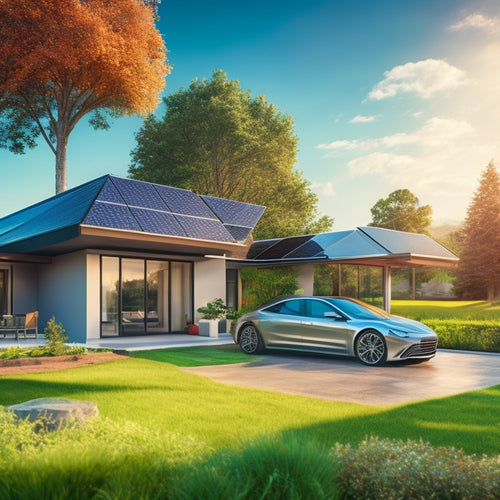
Understanding Home Solar Installation Costs
Share
You're likely to spend around $15,000 to $30,000 or more on a home solar installation, with the overall cost depending on various factors, including the system's size, equipment quality, and local labor prices. The cost can be broken down into components, such as financing options, tax credits, and energy savings, which can offset the initial expense. Factors like system size, labor costs, and permitting fees also impact the final bill. Additionally, equipment quality, installer knowledge, and local incentives can influence the cost. As you investigate your options, understanding these variables will help you make an informed decision - and there's more to reflect on when assessing the benefits of going solar.
Key Takeaways
- Home solar installation costs are affected by system size, energy needs, local labor costs, permitting, and equipment quality.
- Financing options and tax credits can significantly offset upfront installation costs, making solar energy more affordable.
- System warranties typically last 25-30 years, protecting investments and ensuring long-term energy savings.
- Local and state incentives, such as rebates and property tax exemptions, can further reduce solar installation costs.
- Ongoing maintenance expenses, including cleaning and inspections, are necessary to ensure optimal system performance and energy production.
Breaking Down System Costs
Breaking Down System Costs
Clarity emerges when you dissect the cost of a home solar installation into its individual components. This breakdown reveals various factors that contribute to the overall expense.
You'll find that financing options, such as loans or leases, can greatly impact your upfront costs. Additionally, tax credits can provide substantial savings, offsetting a considerable portion of the installation expense.
Over time, energy savings will continue to accrue, providing long-term benefits that extend beyond the initial investment. Moreover, the environmental impact of solar energy can't be overstated, as it reduces your reliance on fossil fuels and lowers your carbon footprint.
System warranties, typically ranging from 25 to 30 years, guarantee that your investment is protected. Installation timelines vary, but most projects are completed within a few weeks.
Factors Affecting Installation Prices
You'll find that several key factors influence the final cost of your home solar installation.
The size of the system you need, local labor costs, and the expenses associated with permitting and inspection all play a significant role in determining the overall price.
As you research and compare installation quotes, understanding how these factors impact your costs will help you make an informed decision.
System Size Matters
As you investigate the world of home solar installation, one of the most significant factors affecting the overall cost is the system size, which directly correlates with the number of panels required to meet your energy needs.
When it comes to system size, you'll want to take into account the following key factors that impact installation costs:
-
Energy consumption: The more energy you need, the larger the system required, and the higher the cost. Assess your energy usage patterns to determine the ideal system size.
-
Roof size and layout: The available roof space and its layout will influence the system size and number of panels needed. A larger roof can accommodate more panels, reducing the cost per watt.
-
System performance: The quality and efficiency of the solar panels and inverters will affect the overall system performance and cost. Look for systems with high-efficiency panels and reliable inverters to maximize your solar energy trends and system performance.
Local Labor Costs
Your solar panel system's size is just one piece of the cost puzzle. Another vital factor is local labor costs, which can vary greatly depending on where you live.
Wage variations across regions, cities, and even neighborhoods can impact the overall installation price. For instance, areas with high costs of living, such as major cities, tend to have higher labor costs.
Regional differences in the labor market, like union presence or technician training, can also influence local labor costs. When comparing costs, consider that local regulations, such as licensing requirements or building codes, can affect labor prices.
Furthermore, demand fluctuations in the local market can drive up or down labor costs. It's important to research local labor costs to make informed cost comparisons.
Permitting and Inspection
Solar panels can't simply be installed without proper permits and inspections, and these necessary steps come with a price tag.
You'll need to take into account the cost of obtaining the required permits and undergoing inspections to guarantee your solar panel system meets local building codes and safety standards.
The permitting process typically involves submitting plans and blueprints to your local government, which then reviews and approves them. This process can take several weeks to a few months, depending on the complexity of your project and the workload of your local permitting office.
Here are some key inspection requirements you'll need to bear in mind:
-
Electrical inspection: Verifies that your solar panel system is properly connected to the electrical grid and meets safety standards.
-
Building inspection: Confirms that your solar panel system is installed according to local building codes and doesn't compromise the structural integrity of your roof.
-
Fire inspection: Checks that your solar panel system meets local fire safety codes, including clearance requirements and access for firefighters.
These inspections and permits can add up to $1,000 to $2,000 to your overall installation cost, depending on your location and the complexity of your project.
Equipment Costs and Quality
You're likely to spend the bulk of your home solar installation budget on equipment costs, which can range from 60% to 80% of the total expenditure. This includes the cost of solar panels, inverters, and other essential components.
The type of solar panels you choose can greatly impact the overall cost, with monocrystalline panels being more expensive than polycrystalline ones. Inverter options also vary, with string inverters being a more affordable option and microinverters providing greater energy efficiency.
Battery storage is another important consideration, as it allows you to store excess energy generated during the day for use at night or during power outages.
Look for installation warranties that cover the equipment and labor for at least 25 years. A reputable manufacturer with a proven track record of producing high-quality equipment can guarantee a longer system longevity and a greater return on investment.
Additionally, financing options can help make the upfront cost more manageable. By choosing high-quality equipment, you can maximize your energy efficiency, reduce your environmental impact, and enjoy the benefits of renewable energy for years to come.
Labor Costs and Expertise
When considering labor costs for your home solar installation, you'll want to evaluate the qualifications of the installer, as a more experienced team can reduce errors and complete the job more efficiently.
The project management process also plays a significant role, as a well-coordinated team can minimize delays and guarantee a smooth installation.
Additionally, the availability of skilled technicians can impact the overall cost, as their proficiency can optimize system performance and ascertain compliance with local building codes.
Installer Qualifications Matter
Five key factors influence the cost of a home solar installation, and one of them is the installer's qualifications. You want to verify that the installer you choose has the necessary proficiency to get the job done efficiently and effectively.
When evaluating an installer's qualifications, consider the following factors:
-
Installer Experience: Look for installers with a proven track record of completing successful solar installations. The more experience they have, the better equipped they'll be to handle any challenges that arise during your project.
-
Certification Requirements: Check if the installer meets certification requirements, such as those set by the North American Board of Certified Energy Practitioners (NABCEP). This guarantees they've the necessary knowledge and skills to design and install a safe and efficient solar system.
-
Manufacturer Training: Verify that the installer has received training from the manufacturer of the equipment they're using. This training provides them with comprehensive knowledge of the products and helps them optimize system performance.
Project Management Efficiency
Project management efficiency is a critical component of the overall cost of your home solar installation, as it directly impacts labor costs and skill. When you hire an installer, you're not just paying for their technical knowledge, but also their ability to manage the project effectively.
A well-managed project guarantees that the installation is completed on time, within budget, and to your satisfaction. This is where project timelines and resource allocation come into play. An efficient project manager will allocate resources effectively, ensuring that the right personnel are assigned to each task, and that the project stays on schedule.
This not only reduces labor costs but also minimizes the risk of delays and rework. By streamlining the installation process, a project manager can pass the savings on to you, the customer.
Look for an installer with a proven track record of managing projects efficiently, and ask about their project management process to guarantee you're getting the best value for your investment.
Skilled Technician Availability
Proficiency is the backbone of a successful home solar installation, and it all starts with the availability of skilled technicians. As you consider investing in solar power, you need to guarantee that the technicians handling your installation are well-trained and experienced. This is essential because skilled technicians can greatly impact the overall cost and quality of your installation.
Here are three key factors that influence skilled technician availability:
-
Technician training: The quality of technician training programs directly affects the number of skilled professionals available in the market. Look for installers that invest in ongoing training and certification programs to validate their technicians are up-to-date with the latest technology advancements.
-
Technology advancements: The rapid evolution of solar technology requires technicians to constantly update their skills. Installers that adopt new technologies and provide training on these advancements can attract and retain skilled technicians.
-
Labor market conditions: Local labor market conditions, such as competition and workforce availability, can impact the availability of skilled technicians. Installers that offer competitive wages and benefits can attract top talent in a tight labor market.
Local and State Incentives
As you traverse the process of installing solar panels on your home, it's vital to contemplate the various local and state incentives that can greatly reduce the overall cost. Many states and local governments offer incentives to encourage the adoption of renewable energy sources like solar power. These incentives can come in the form of tax credits, rebates, or property tax exemptions.
You'll want to research the specific incentives available in your area, as they can vary widely. For example, some states offer a state tax credit in addition to the federal tax credit of 26% of the total installation cost.
Additionally, some utilities and local governments offer rebates or discounts on your electricity bill. It's important to factor these incentives into your overall cost calculation to get an accurate depiction of your solar installation's return on investment.
Roof Size and Complexity
In conjunction with your solar panel system's overall size, the intricacy of your roof plays a significant role in determining the installation cost. A more complicated roof design can increase the installation time, thereby driving up costs.
When evaluating your roof's intricacy, consider the following factors:
-
Roof orientation: The direction your roof faces affects the amount of sunlight your solar panels receive. Ideal orientations are south-facing, with minimal shading.
-
Shading analysis: Obstacles like trees, chimneys, or skylights can cast shadows on your roof, reducing energy production. A thorough shading analysis helps identify and mitigate these issues.
-
Roof layout and obstructions: A roof with multiple levels, skylights, or vents can make installation more challenging, increasing labor costs.
These factors influence the installation cost, as they may require additional equipment, labor, or design accommodations.
Understanding your roof's intricacy helps you accurately estimate the installation cost and optimize your solar panel system's performance.
Ongoing Maintenance Expenses
While your roof's intricacy affects the upfront installation cost, it's equally important to reflect on the long-term expenses associated with maintaining your solar panel system.
You'll need to take into account the warranty coverage, which typically lasts between 10 to 25 years, depending on the manufacturer. During this period, you'll need to perform routine maintenance tasks, such as cleaning the panels to guarantee peak performance. The maintenance frequency will depend on your location, with areas prone to heavy debris or extreme weather conditions requiring more frequent cleaning.
You'll also need to invest in performance monitoring systems to track your energy production and identify potential issues. Regular professional inspections can help detect problems early on, reducing the need for costly repairs.
As your system ages, you may need to perform system upgrades or replace components, such as inverters, to maintain efficiency. Troubleshooting techniques and component lifespan knowledge will help you extend the life of your system.
Weather considerations, such as extreme temperatures and humidity, will also impact your maintenance strategy. By factoring in these ongoing expenses, you'll get a more accurate estimate of your solar panel system's total cost of ownership.
Frequently Asked Questions
Can I Install Solar Panels on a Rental Property?
Are you ready to utilize the sun's energy on your rental property? You'll need to secure your landlord's permission, ensuring it aligns with your rental agreements, before installing solar panels, as you'll be making modifications to the property.
Do Solar Panels Affect My Home's Resale Value?
When you install solar panels, you're making a significant solar investment, which can enhance your home's resale value by up to 17%, according to a property appraisal study, making your property more attractive to potential buyers.
Can I Add More Panels to My Existing System?
You can add more panels to your existing system if they're compatible, but you'll need to assess panel compatibility and guarantee a seamless installation process, which might require upgrading your inverter or electrical infrastructure.
Will Solar Panels Work During a Power Outage?
Like a ship without anchor, you're left in the dark during a power outage, wondering if your solar panels will keep you afloat. Unfortunately, they won't function during an outage, unless you have a battery backup system, which provides a reliable power outage solution.
Can I Install Solar Panels on a Metal Roof?
You can install solar panels on a metal roof, leveraging its advantages like durability and heat resistance, but be prepared to overcome installation challenges like specialized mounting systems and potential corrosion risks.
Related Posts
-

What Solar Panels Work Best With EVS Online?
When shopping for solar panels online to power your electric vehicle, look for high-efficiency models that can withst...
-

Top Online Stores for Solar Car Accessories
When searching online for solar car accessories, you'll find top retailers like Amazon, REI Co-op, and Best Buy offer...
-

Safety First: Why Seniors Need Advanced Vehicle Features
As you get behind the wheel, you're likely unaware that seniors are 16% more likely to be involved in a fatal car cra...


